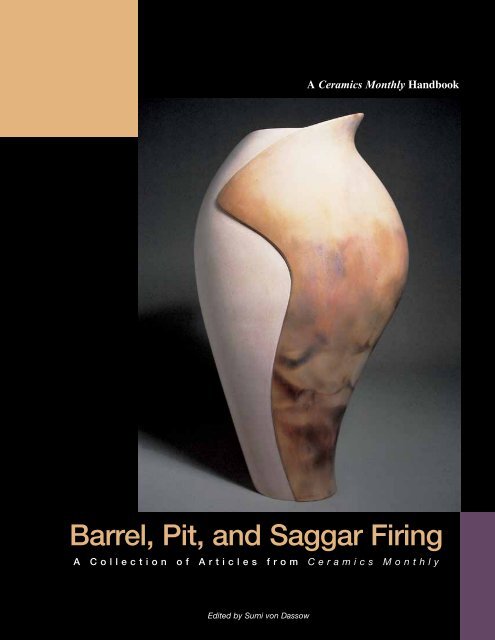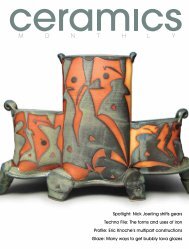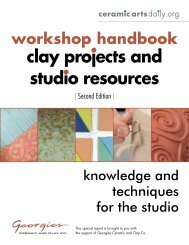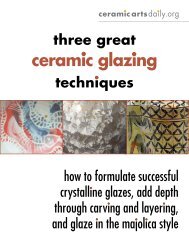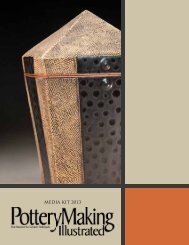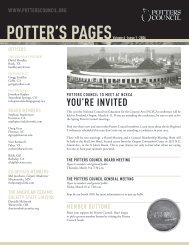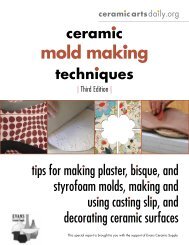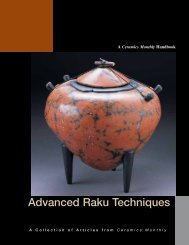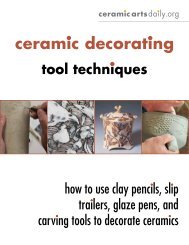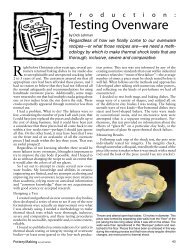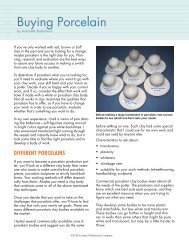Barrel, Pit, and Saggar Firing - Ceramic Arts Daily
Barrel, Pit, and Saggar Firing - Ceramic Arts Daily
Barrel, Pit, and Saggar Firing - Ceramic Arts Daily
Create successful ePaper yourself
Turn your PDF publications into a flip-book with our unique Google optimized e-Paper software.
<strong>Barrel</strong>, <strong>Pit</strong>, <strong>and</strong> <strong>Saggar</strong> <strong>Firing</strong><br />
A Collection of Articles from <strong>Ceramic</strong>s Monthly<br />
Edited by Sumi von Dassow<br />
A <strong>Ceramic</strong>s Monthly H<strong>and</strong>book
<strong>Barrel</strong>, <strong>Pit</strong>, <strong>and</strong> <strong>Saggar</strong> <strong>Firing</strong><br />
A Collection of Articles from <strong>Ceramic</strong>s Monthly<br />
Edited by Sumi von Dassow<br />
i<br />
Published by<br />
The American <strong>Ceramic</strong> Society<br />
600 N. Clevel<strong>and</strong> Ave., Suite 210<br />
Westerville, Ohio 43082<br />
www.<strong>Ceramic</strong><strong>Arts</strong> <strong>Daily</strong>.org
The American <strong>Ceramic</strong> Society<br />
600 N. Clevel<strong>and</strong> Ave., Suite 210<br />
Westerville, OH 43082<br />
© 2001, 2011 by The American <strong>Ceramic</strong> Society, All rights reserved.<br />
ISBN: 1-57498-127-7 (Paperback)<br />
ISBN: 978-1-57498-306-7 (PDF)<br />
No part of this book may be reproduced, stored in a retrieval system or transmitted in any form or by any means, electronic, mechanical,<br />
photocopying, microfilming, recording or otherwise, without written permission from the publisher, except by a reviewer, who may quote<br />
brief passages in review.<br />
Authorization to photocopy for internal or personal use beyond the limits of Sections 107 <strong>and</strong> 108 of the U.S. Copyright Law is granted by<br />
The American <strong>Ceramic</strong> Society, provided that the appropriate fee is paid directly to the Copyright Clearance Center, Inc., 222 Rosewood<br />
Drive, Danvers, MA 01923 U.S.A., www.copyright.com. Prior to photocopying items for educational classroom use, please contact<br />
Copyright Clearance Center, Inc. This consent does not extend to copyright items for general distribution or for advertising or promotional<br />
purposes or to republishing items in whole or in part in any work in any format. Requests for special photocopying permission <strong>and</strong> reprint<br />
requests should be directed to Director, Publications, The American <strong>Ceramic</strong> Society, 600 N. Clevel<strong>and</strong> Ave., Westerville, Ohio 43082 USA.<br />
Every effort has been made to ensure that all the information in this book is accurate. Due to differing conditions, equipment, tools, <strong>and</strong><br />
individual skills, the publisher cannot be responsible for any injuries, losses, <strong>and</strong> other damages that may result from the use of the<br />
information in this book. Final determination of the suitability of any information, procedure or product for use contemplated by any user,<br />
<strong>and</strong> the manner of that use, is the sole responsibility of the user. This book is intended for informational purposes only.<br />
The views, opinions <strong>and</strong> findings contained in this book are those of the author. The publishers, editors, reviewers <strong>and</strong> author assume no<br />
responsibility or liability for errors or any consequences arising from the use of the information contained herein. Registered names <strong>and</strong><br />
trademarks, etc., used in this publication, even without specific indication thereof, are not to be considered unprotected by the law. Mention<br />
of trade names of commercial products does not constitute endorsement or recommendation for use by the publishers, editors or authors.<br />
Publisher: Charles Spahr, Executive Director, The American <strong>Ceramic</strong> Society<br />
Art Book Program Manager: Bill Jones<br />
Editor: Sumi von Dassow<br />
Ebook Manager: Steve Hecker<br />
Graphic Design: Melissa Bury, Bury Design, Westerville, Ohio<br />
Graphic Production: David Houghton<br />
Cover Image: Porcelain Vase by Rebecca Urlacher<br />
ii
PREFACE<br />
This book was created in response to a growing interest in pit firing<br />
<strong>and</strong> related techniques in the pottery-making community, as reflected in<br />
ceramic art shows <strong>and</strong> in the ceramic art press. As issues of function have<br />
decreased in importance in the minds of the public <strong>and</strong> potters alike, <strong>and</strong><br />
the line between pottery <strong>and</strong> art has blurred, such firing methods cease to<br />
be thought of as “alternative” or “experimental.” Potters, ceramic artists,<br />
<strong>and</strong> sculptors wish to use whatever forming, decorating, <strong>and</strong> firing techniques<br />
are necessary to articulate their vision.<br />
The articles included in this book were carefully selected from the<br />
pages of <strong>Ceramic</strong>s Monthly magazine to illustrate the multiplicity of approaches<br />
to barrel, pit, <strong>and</strong> saggar firing. Herein are works of art ranging<br />
from wheel-thrown <strong>and</strong> coil-built pots to complex sculptures, tied together<br />
by a similarity in the firing process. Some of the articles were chosen<br />
because they illuminate the basic or “st<strong>and</strong>ard” version of barrel, pit, or<br />
saggar firing; others to illustrate variations on the theme; <strong>and</strong> still others<br />
to demonstrate some of the techniques used to create pottery or sculpture<br />
destined for the pit or the saggar.<br />
It is the earnest hope of the editors of The American <strong>Ceramic</strong> Society,<br />
<strong>Ceramic</strong>s Monthly magazine, <strong>and</strong> of this book that artists, teachers, students,<br />
<strong>and</strong> collectors alike will find value in these pages. Whether that is by<br />
ceramic artists <strong>and</strong> students as inspiration for new work, or by teachers as<br />
a source of ideas for projects or workshops, or by pottery aficionados as a<br />
stepping stone to greater underst<strong>and</strong>ing of the art, we hope it brings enjoyment<br />
to all who read it.<br />
iii<br />
—Sumi von Dassow
ContEntS<br />
Preface ....................................................................................................v<br />
IntroductIon: the allure of PIt <strong>and</strong> <strong>Saggar</strong> fIrIng .........................1<br />
chaPter 1: the rootS of PIt fIrIng: raku meetS amerIcan IndIan Pot-<br />
tery <strong>and</strong> a new amerIcan technIque IS born<br />
Finding Oaxaca by Eric Mindling ..............................................................10<br />
An overview of the pottery-making <strong>and</strong> firing techniques of Native American potters<br />
in Oaxaca, Mexico<br />
All That Glitters by Constance Shunk .......................................................16<br />
A description of the use of micaceous clay by Native American potters of New<br />
Mexico to create functional pottery using traditional techniques<br />
Tammy Garcia by Gail Molnar Pfeifer ......................................................18<br />
A Santa Clara potter uses traditional techniques to create work straddling the<br />
boundary between traditional Indian pottery <strong>and</strong> contemporary ceramic art<br />
Raku Then <strong>and</strong> Now by Hal Riegger .........................................................22<br />
Riegger describes his early experiments with raku <strong>and</strong> “primitive” firings<br />
chaPter 2: PIt fIrIng: a unIque amerIcan fIrIng technIque<br />
<strong>Pit</strong> <strong>Firing</strong> in North Carolina by Dan <strong>and</strong> Linda Riggs .............................27<br />
A description of the pit firing techniques of Edge Barnes <strong>and</strong> Zoie Holtzknecht<br />
Energy <strong>and</strong> Care: <strong>Pit</strong> <strong>Firing</strong> Burnished Pots on the Beach<br />
by Carol M. Prier .........................................................................................31<br />
Prier describes the evolution of her pit firing method, using cow dung for fuel<br />
Embree de Persiis by Robert Reese ...........................................................35<br />
A pit-firing variation using sawdust for fuel <strong>and</strong> regulating air flow with pierced<br />
stovepipes<br />
Smoked <strong>and</strong> <strong>Pit</strong>-Fired Porcelain by Rebecca Urlacher ............................37<br />
Smoke-firing in a metal can <strong>and</strong> pit firing with charcoal <strong>and</strong> other combustibles<br />
chaPter 3: PItfIrIng brancheS out: PIt <strong>and</strong> SawduSt fIrIng<br />
In brIck chamberS <strong>and</strong> barrelS<br />
Salt <strong>Pit</strong> <strong>and</strong> Sawdust <strong>Firing</strong> by Peter Gibbs ..............................................42<br />
Controlling the variables by pit firing in a brick chamber<br />
Smoke-Fired Pottery by Jane Perryman ....................................................44<br />
Using masking tape <strong>and</strong> slip to create resist-decorated sawdust fired pottery<br />
Jeff Kell by Maryalice Yakutchik ................................................................48<br />
Straw firing large-scale forms in a metal drum<br />
Smoke <strong>and</strong> Color by Glenn Spangler .........................................................51<br />
<strong>Firing</strong> with wood shavings soaked in soluble materials<br />
Madhvi Subrahmanian .............................................................................53<br />
Smoked pottery with layered terra sigillatas<br />
Gabriele Koch ............................................................................................54<br />
Burnished <strong>and</strong> smoked h<strong>and</strong>built vessels<br />
chaPter 4: redIScoverIng the kIln: <strong>Saggar</strong> fIrIng<br />
Low-Temperature Salt/<strong>Saggar</strong> <strong>Firing</strong> by R. Bede Clarke........................56<br />
Suggestions for various materials to use when firing in brick saggars<br />
Decorating with Volatile Materials in <strong>Saggar</strong>s by Ruth Allen .................59<br />
<strong>Saggar</strong> firing burnished <strong>and</strong> etched porcelain pots<br />
Fast Fossils: Carbon-Film Transfer on <strong>Saggar</strong>-Fired Porcelain<br />
by Dick Lehman ...........................................................................................64<br />
The tricky art of transferring silhouettes of vegetation onto a porcelain pot<br />
v
Seashell Fuming by Kelvin Bradford .........................................................68<br />
Relatively high-temperature firing in a saggar filled with seashells<br />
David Atamanchuk by Joel Perron ............................................................72<br />
Relatively high-temperature pottery saggarfired with sawdust<br />
Elisabeth Anderson by Virginia Hillhouse .................................................74<br />
<strong>Firing</strong> burnished pottery filled with damp sawdust<br />
Smokeless <strong>Saggar</strong> <strong>Firing</strong> by Macy Dorf ....................................................78<br />
How to avoid complaints from neighbors about smoke from saggar firing<br />
chaPter 5: returnIng to the rootS: burnIShIng <strong>and</strong> black fIrIng<br />
Juan Quezeda: Potter in a New Tradition by Elaine Levin ...................80<br />
Indian potter Quezeda’s revival of traditional pottery-making <strong>and</strong> firing methods<br />
The Spirit to Learn, the Spirit to Teach by Norbert Turek ......................88<br />
Michael Wisner’s techniques for burnishing <strong>and</strong> black firing, adapted from traditional<br />
techniques learned from Juan Quezeda<br />
Freedom’s Just Another Word by Sumi von Dassow ...............................96<br />
Another method of burnishing <strong>and</strong> black firing in an electric kiln<br />
Burnishing <strong>and</strong> Dung <strong>Firing</strong> by Marsha Judd .......................................100<br />
Judd’s method of burnishing <strong>and</strong> saggar firing with manure<br />
Magdalene Odundo ................................................................................103<br />
Nairobi-born potter’s burnished <strong>and</strong> saggar-fired pottery<br />
chaPter 6: formIng technIqueS for PIt <strong>and</strong> <strong>Saggar</strong> fIrIng<br />
Collaborative Throwing by Susan <strong>and</strong> Jim Whalen ................................108<br />
Four-h<strong>and</strong>ed method of throwing large pots for sawdust firing<br />
A Sense of Timelessness by Jimmy Clark ................................................111<br />
Large-scale pinch pots with terra sigillata, sawdust fired in a pit<br />
A Soulful Sound by Janie Rezner .............................................................114<br />
Making pit- <strong>and</strong> saggar-fired ocarinas<br />
H<strong>and</strong>built Vessels by Dale Allsion Hartley ..............................................116<br />
Low-salt fired slab-built stoneware<br />
Clay, Nails, <strong>and</strong> Smoke by Jerry Caplan ..................................................119<br />
Using nails instead of slip as a fastener for smoke-fired teapot forms<br />
A Female Form: The Sculpture Techniques of Margaret Keelan<br />
by Benny Shaboy .......................................................................................121<br />
Press-molded <strong>and</strong> h<strong>and</strong>built sculptural pieces, smoked with newspaper<br />
Jean-Luc Mas ..........................................................................................124<br />
Burnished <strong>and</strong> smoked stoneware sculpture<br />
Kevin Nierman by David Brin ..................................................................127<br />
Burnished pots broken, sawdust fired, <strong>and</strong> reassembled<br />
chaPter 7: PlayIng wIth fIre: exPerImental kIlnS <strong>and</strong> related<br />
fIrIng methodS<br />
A Paper Kiln by Caroline Court ...............................................................130<br />
Building <strong>and</strong> firing a single-use kiln from wood, chicken wire, <strong>and</strong> paper<br />
Barbeque <strong>and</strong> Fireplace <strong>Firing</strong> by Mollie Poupeney .............................133<br />
Adapting open-firing methods to the suburban environment<br />
Freedom to Discover by Will <strong>and</strong> Kate Jacobson ....................................137<br />
Using post-firing reduction stencilling to create carbon-saturated patterns<br />
Bennett Bean: Playing by His Rules by Karen S. Chambers ..................140<br />
<strong>Pit</strong> firing wheel-thrown <strong>and</strong> altered glazed earthenware<br />
Vapor Glazing in a <strong>Saggar</strong> by Richard Behrens ......................................144<br />
<strong>Firing</strong> unglazed ware in a saggar painted with easily volatilized glaze mixtures<br />
Low-Fire-Salt Fuming by Paul Soldner ...................................................145<br />
Suggestions for successful low-temperature salt fuming in a gas kiln<br />
vi
IntRoduCtIon<br />
The Allure of <strong>Pit</strong> <strong>and</strong> <strong>Saggar</strong> <strong>Firing</strong><br />
Since the first fired clay pot was made, perhaps accidentally by leaving a mudlined<br />
basket too close to a fire, the potter has had fire as an active collaborator.<br />
During the millennia since then, progress in pottery technology has usually meant<br />
taming the fire—making it hotter, cleaner, more controlled, <strong>and</strong> more predictable.<br />
In much of the world, firing on the open ground gave way to firing inside<br />
a pit, then kilns were built to contain the fire. Refinements including chimneys<br />
<strong>and</strong> air intakes to improve air flow <strong>and</strong> control the temperature <strong>and</strong> atmosphere;<br />
fireboxes to separate the fuel from the ware; <strong>and</strong> saggars to protect the ware from<br />
the smoke, all served to reduce the direct contact of fire with clay. The ultimate<br />
advance in this direction, the electric kiln, allows the potter to apply heat to clay<br />
without requiring any flame at all. For many potters, this advance has eased the<br />
task of creating functional pottery; it has opened up the pursuit of pottery to many<br />
as a hobby, removed much of the stress of firing delicate work, <strong>and</strong> furthered the<br />
development of beautiful new glaze types.<br />
However, along with the<br />
stress, the electric kiln has removed<br />
much of the excitement<br />
of firing, the sense of having an<br />
inanimate <strong>and</strong> unpredictable collaborator,<br />
<strong>and</strong> the eager anticipation<br />
attending a kiln opening. If<br />
the flame <strong>and</strong> the smoke aren’t<br />
present to ruin pots, neither are<br />
they there to enhance them. Thus,<br />
since the electric kiln has become<br />
ubiquitous <strong>and</strong> indispensable,<br />
interest has mounted in alternative<br />
firing methods involving fuel <strong>and</strong><br />
flame. This interest has extended<br />
in two directions. Though timeconsuming<br />
<strong>and</strong> labor-intensive,<br />
high-temperature wood-firing has<br />
captured the enthusiasm of many<br />
potters. In a wood kiln, the element<br />
of the unpredictable comes to play in the way the fire colors glazes applied before<br />
firing, as well as in allowing the ash produced in firing to form a glaze wherever it<br />
1 The Roots of <strong>Pit</strong> <strong>Firing</strong>
l<strong>and</strong>s on the unglazed pottery. In either case, the result is fully vitreous, glazed or<br />
partially glazed pottery.<br />
Other potters have taken quite a different approach to playing with fire. Potters<br />
working without a kiln at all, without glazes, arranging fuel <strong>and</strong> ware on the<br />
ground or in simple containers, can produce beautiful works of art colored only<br />
by smoke <strong>and</strong> fumes. While Native American or African potters firing in the open<br />
without electricity or kilns may regard smoke marks as a defect, many potters<br />
from industrialized countries are delighted with precisely such unpredictable<br />
effects <strong>and</strong> seek to capture them in a variety of firing methods. Along with the<br />
growing popularity of raku, the last quarter of the 20th century has seen experimentation<br />
with firing in pits <strong>and</strong> barrels packed with sawdust, newspaper, pine<br />
needles, <strong>and</strong> other combustibles. The saggar, invented to protect glazed pottery<br />
from the sulphur produced by coal-burning kilns, now has a new function—<br />
packed with pottery, combustibles, <strong>and</strong> volatile materials, <strong>and</strong> placed inside a gas<br />
kiln, it brings back the drama of firing.<br />
Whether in a pit or a barrel, or in a saggar inside a gas kiln, the firing methods<br />
under discussion have several features in common. They are generally<br />
low-temperature techniques, not usually requiring large amounts of time, fuel,<br />
or manpower. The low temperature <strong>and</strong> usually short firing time means that the<br />
results of a firing are known quickly, <strong>and</strong> firings can take place frequently. They<br />
do not involve glaze, relying on smoke <strong>and</strong> volatile materials for effect. Thus, the<br />
resulting pots are decorative rather than functional, <strong>and</strong> relatively fragile. This<br />
means, however, that such a firing may take place with less preparation time. In<br />
addition, the equipment requirements are minimal <strong>and</strong> easy to improvise. Lowtemperature<br />
smoke firing can be adapted to fire one piece at a time, or many. The<br />
investment in a single firing is smaller, allowing the potter to indulge in the urge<br />
to experiment. All of these features make this type of firing an attractive possibility<br />
for many who would like to collaborate with fire but do not have access to an<br />
wood-burning kiln.<br />
<strong>Pit</strong> <strong>and</strong> saggar firing are versatile techniques. There is no right or wrong firing<br />
technique, no correct outcome. Success or failure are entirely subjective concepts.<br />
The variables involved in pit <strong>and</strong> saggar firing are so many: the types of clay <strong>and</strong><br />
fuel; the size, surface <strong>and</strong> bisque temperature of the ware to be fired; the climate<br />
<strong>and</strong> the condition of the earth into which the pit is dug; the type <strong>and</strong> size of barrel<br />
or saggar; <strong>and</strong> other differences from one potter to another, often render futile<br />
any attempt to duplicate exactly another’s results. Therefore, there are as many<br />
ways of pit <strong>and</strong> saggar firing as there are potters. Each potter who begins working<br />
in this evolving field embarks on a journey of discovery, guided by the happy<br />
<strong>Barrel</strong>, <strong>Pit</strong>, <strong>and</strong> <strong>Saggar</strong> <strong>Firing</strong> 2
accident, on which a personal style of firing is developed. The artists profiled in<br />
the following pages combine the elements of pottery, combustible materials, <strong>and</strong><br />
flame in unique ways that satisfy their own aesthetic sense. Reading about their<br />
discoveries may inspire some to embark on their own journey; others may simply<br />
realize a greater appreciation for the effort which went into creating each beautiful<br />
or intriguing work of earth <strong>and</strong> fire.<br />
If you are reading this book because you are interested in trying some of these<br />
firing methods, you may find it helpful to consider your own circumstances <strong>and</strong><br />
the types of clay, equipment <strong>and</strong> fuel at your disposal. Before you read about the<br />
(perhaps bewildering) variety of possible firing techniques, I offer a brief section<br />
of questions <strong>and</strong> answers to help with this process of sorting out the possibilities.<br />
Which Kind of <strong>Firing</strong> is Right for You?<br />
Your choice of firing method depends either on your circumstances or the<br />
particular effect you desire. If you have access to a beach <strong>and</strong> can get permission<br />
to dig a pit <strong>and</strong> fire there, pit firing is fun <strong>and</strong> exciting. If you want to fire a small<br />
number of pots at one time, or can’t dig a pit, you may want to try a barrel or saggar<br />
firing. If you have concerns about annoying the neighbors with smoky outdoor<br />
firings, or you want greater control over the results of each firing, saggar firing<br />
may be your best option. If you are not sure whether you want to fire in a pit, a<br />
barrel, or a saggar the following questions <strong>and</strong> answers will help you decide.<br />
What are the best choices for color development?<br />
A protracted firing in a pit or a large brick chamber, such as Peter Gibbs describes,<br />
will give the best chance for color development. Edge Barnes <strong>and</strong> Zoie<br />
Holtzknecht add copper to produce red flashing, in the form of copper sulfate<br />
<strong>and</strong> wire. For yellow colors they sprinkle salt <strong>and</strong> baking soda into the pit. Carol<br />
Molly Prier uses copper carbonate instead of sulfate, <strong>and</strong> adds seaweed to her pits<br />
as another source of salt. Other possible treatments for interesting color development<br />
are spraying or soaking bisqueware in solutions of cobalt or iron sulfate,<br />
as Gibbs does. To vary the results from pot to pot within a single pit, Embree de<br />
Persiis places pierced pieces of stovepipe over pots in the pit. Barnes <strong>and</strong> Holtzknecht<br />
may use steel or clay bowls as saggars for individual pots, or wrap pots in<br />
newspaper to hold various combustible <strong>and</strong> volatile materials close to the pot’s<br />
surface. Rebecca Urlacher speeds up her pit firings a bit by setting preheated pots<br />
onto a bed of hot coals covered with additional fuel <strong>and</strong> volatile materials.<br />
<strong>Pit</strong> firing is a great project for classes, workshops, <strong>and</strong> cooperative groups<br />
since a pit can be as large as needed <strong>and</strong> there will be plenty of work for all. <strong>Pit</strong><br />
3 The Roots of <strong>Pit</strong> <strong>Firing</strong>
firing can be used for a small number of pots, as well, simply by digging a smaller<br />
pit. However, digging a pit each time you have a few pots to fire, then filling it in<br />
<strong>and</strong> removing ashes <strong>and</strong> coals afterwards means preparation <strong>and</strong> cleanup become<br />
a time-consuming chore for an individual potter. Digging a permanent pit or<br />
building a firing chamber can solve this problem, but you may then have to wait<br />
for enough pots to fill it up before you can fire.<br />
What if I want color but don’t have a place to dig a pit or room to<br />
build a brick chamber?<br />
You can achieve a similar look working on a smaller scale in a barrel or can<br />
with air-holes punched in. Before firing pots in any such container it should be<br />
prepared by building a fire in it to burn off any volatile materials it may have been<br />
coated with. Since such a firing won’t get as hot nor last quite so long as in a large<br />
pit, it is possible to encourage color development by spraying a copper matte solution<br />
on pots before firing, as Jeff Kell does. Glenn Spangler soaks wood shavings in<br />
soluble materials, including copper sulfate <strong>and</strong> fabric paint, before loading shavings<br />
<strong>and</strong> pots into a can for firing.<br />
<strong>Barrel</strong> or can firing is ideal for small batches of one to several pots, <strong>and</strong> containers<br />
of various sizes—from an oil drum or garbage can, to a popcorn tin—can<br />
be used. Since the cans are permanent firing chambers, setup <strong>and</strong> cleanup time<br />
may be reduced over pit firing, though for a group of potters with a large number<br />
of pots it may be tedious to prepare enough cans <strong>and</strong> barrels.<br />
How can I achieve the effect of a pit firing if open burning is not feasible?<br />
If you have a gas kiln you can place your work in a saggar, along with combustible<br />
<strong>and</strong> volatile materials, <strong>and</strong> fire to a relatively low temperature. R. Bede<br />
Clarke applies soluble materials directly to bisqueware by brushing, spraying,<br />
pouring or dipping. Ruth Allan uses wire <strong>and</strong> filings of various metals, <strong>and</strong> even<br />
masking tape, to enhance color.<br />
Traditionally, a large lidded clay cylinder is made to serve as a saggar (see p.57<br />
for saggar clay recipe). Clay or stainless steel bowls, or even terra cotta flower<br />
pots, can serve as ready-made saggars. Clarke <strong>and</strong> Allan find it simpler <strong>and</strong> more<br />
versatile to build a saggar of bricks around the pots inside the kiln. Elisabeth Anderson<br />
dispenses with the saggar, by firing inside out—she applies salt <strong>and</strong> wire<br />
to the outer surface of her pots, then fills them with sawdust before firing in a kiln.<br />
If smokestack emissions of saggar firing are a problem, Macy Dorf offers suggestions<br />
for smoke-free saggar firing.<br />
<strong>Barrel</strong>, <strong>Pit</strong>, <strong>and</strong> <strong>Saggar</strong> <strong>Firing</strong> 4
How can I achieve smoke markings without added color?<br />
R<strong>and</strong>om markings from swirling smoke are easy to produce, <strong>and</strong> the firing<br />
needn’t be very hot or very lengthy. Rebecca Urlacher, for example, smokes some<br />
of her forms using crumpled newspaper in a metal can for just two minutes before<br />
pulling the pieces out of the fire. Jerry Caplan also smokes his pots with newspaper<br />
for only a few minutes, though he uses a stream of forced air to raise the<br />
temperature of the fire.<br />
If newspaper smoking doesn’t produce an interesting enough surface, pots can<br />
be buried in sawdust or wood shavings in a barrel or brick chamber, set alight with<br />
the aid of crumpled newspaper, kindling, <strong>and</strong> charcoal lighter fluid. Depending<br />
on the size of the container, a sawdust fire may burn overnight before going out.<br />
Sawdust-fired pots may emerge almost black, or merely marked with a few dark<br />
clouds—the variables being the type of clay, temperature to which it was bisqued,<br />
how much air gets into the firing chamber, <strong>and</strong> how thoroughly the sawdust burns.<br />
Jane Perryman fires this way to allow carbon to penetrate deeply into the clay.<br />
Smoke-markings can also be produced by firing pots in a saggar in a gas kiln.<br />
Dick Lehman has developed a uniquely controlled firing process in which he is able<br />
to print the silhouettes of vegetation onto his pots in a sawdust-filled saggar. Marsha<br />
Judd fires in a brick saggar using manure as her fuel, <strong>and</strong> her sense of smell to let her<br />
know when to shut off the kiln. It is also possible to do the same thing using sawdust<br />
or wood shavings. The firing is essentially the same as saggar firing for color, without<br />
the need for adding volatile materials or oxides.<br />
How can I produce completely black pots?<br />
Curiously enough, a perfectly black surface can be the most difficult to<br />
achieve. Often a sawdust firing will produce pots that are almost all black, but<br />
achieving a uniformly black surface this way is hit-or-miss. Blackening a pot<br />
depends on building a fire hot enough to allow carbon to penetrate the clay, then<br />
smothering the fire so the clay doesn’t reoxidize. Marsha Judd embeds her pots in<br />
manure in a saggar, <strong>and</strong> fires until the manure smokes but hasn’t yet burned away.<br />
This is similar in technique to a sawdust firing—the difference is that manure<br />
naturally creates a heavy ash, which prevents oxygen from reaching the pots.<br />
Often, however, it is best to isolate the clay from the fuel so the smoke can<br />
reach all parts of the pot <strong>and</strong> there is no danger that unburned fuel will blanket<br />
some part of the pot <strong>and</strong> keep it from becoming black. Michael Wisner has developed<br />
two ways to accomplish this. To fire outside, he stacks pots on firing st<strong>and</strong>s<br />
over sawdust, then covers the stack with a barrel. He builds a fire around the barrel,<br />
to create enough heat to cause the sawdust inside to smoke. Alternatively, he<br />
5 The Roots of <strong>Pit</strong> <strong>Firing</strong>
can stack pots the same way inside a gas kiln, using a metal barrel as a saggar. I<br />
wrap pots in newspaper <strong>and</strong> then in tin foil, <strong>and</strong> fire in a kiln just until the newspaper<br />
smokes, which I refer to as a “modified saggar firing.”<br />
Trickiest of all is a silvery black surface. This can be encouraged by firing<br />
with damp fuel, so Judd sometimes dampens some of the manure in her saggar. If<br />
the silvery surface develops, it’s great; if not, the pots are still a rich, deep black.<br />
Wisner’s secret to the coveted silvery color is to burnish with graphite.<br />
What Type of Clay Should You Use?<br />
There is, of course, no one type of clay that will work best for the many different<br />
types of low-temperature smoke firing. Some potters use porcelain for the<br />
whiteness; others use a buff clay for a little extra color. For some effects, a red<br />
clay is most desirable. A raku-type clay may be appropriate, if the firing will be<br />
quick, to reduce firing losses. Though pit, barrel, <strong>and</strong> saggar firing are all lowtemperature<br />
techniques, it does not necessarily follow that a low-temperature clay<br />
is best. You will want to select the clay according to the type of firing you plan<br />
to do, <strong>and</strong> the effects you want to achieve—though if you have a favorite clay, it<br />
may be equally appropriate to experiment with a variety of firing methods to find<br />
the one that suits the clay best.<br />
What type of clay is best for color development?<br />
You will want a white or light-colored clay. A red clay will not show the subtle<br />
colors from copper <strong>and</strong> salt. Carol Molly Prier prefers a buff to tan clay body<br />
to develop darker oranges <strong>and</strong> reds. On the other h<strong>and</strong>, Rebecca Urlacher pit fires<br />
porcelain, <strong>and</strong> Glenn Spangler also uses porcelain for subtle color development<br />
from soluble materials. If you insist on using porcelain for its whiteness, you may<br />
have to accept a few losses from thermal shock, or carefully preheat pots before<br />
placing them in a pit or barrel. After having experienced a great number of such<br />
firing losses, Ruth Allan offers some suggestions for protecting porcelain from the<br />
stresses of sawdust firing in a saggar. Jeff Kell uses a heavily grogged sculpture<br />
clay to make his large forms, which are fired in a barrel.<br />
Most potters bisque fire their pots before subjecting them to a pit or saggar<br />
fire, both to protect the pots from thermal shock <strong>and</strong> to ensure that the pots have<br />
been fired to sufficient hardness. The temperature of the bisque fire is usually between<br />
cone 012 <strong>and</strong> cone 06—the lower temperature is preferable if the pots have<br />
been burnished. If the bisque temperature is too high, the clay will be less receptive<br />
to color development. Thus, stoneware clay will tend to give better results<br />
than low-fire clay, because it will be less vitrified after bisque firing.<br />
<strong>Barrel</strong>, <strong>Pit</strong>, <strong>and</strong> <strong>Saggar</strong> <strong>Firing</strong> 6
What type of clay is best for smoke firing without added colorants?<br />
The same types of clays that work for pit firing will also work for smoking<br />
pots. Since you won’t be concerned with developing colors from copper, salt, or<br />
sulfates you can choose a darker clay. Smoke markings on red clay can look very<br />
dramatic, though a white clay will show a greater range of grays <strong>and</strong> browns from<br />
the smoke. Just as for a pit firing, a stoneware clay bisqued between cone 012 <strong>and</strong><br />
06 will pick up more color than a clay bisqued to maturity. It is especially important<br />
to bisque fire pots first if you will be using only newspaper for smoking, since<br />
a newspaper fire will not achieve high temperatures.<br />
Many potters who smoke fire like to burnish their pots, or at least smooth the<br />
surface with a rubber kidney rib. A smooth surface will st<strong>and</strong> up to close inspection<br />
better than a rough one, <strong>and</strong> the subtle cloud-like markings of smoke invite<br />
close observation. Therefore, a relatively smooth clay, allowing ease of burnishing,<br />
may be a good choice.<br />
What type of clay is best for black firing?<br />
I use a smooth cone 6 red clay for burnishing <strong>and</strong> black firing because it is<br />
easy to h<strong>and</strong>build, is durable even when fired to quite a low temperature, burnishes<br />
well, <strong>and</strong> reduces to a rich black color. On the other h<strong>and</strong>, Michael Wisner uses a<br />
low-fire white clay, because it most closely duplicates the clay used by the Pueblo<br />
potters with whom he has studied. Marsha Judd uses a red earthenware <strong>and</strong> adds<br />
5% pyrophyllite to achieve a brilliantly burnished surface. Clearly, there is some<br />
room for experimentation <strong>and</strong> personal preference—though a high-fire white clay<br />
or porcelain is not the best choice if a reasonable fired strength is desired.<br />
For the best results when black firing, pots should be unbisqued or bisqued to<br />
a very low temperature such as cone 018. In general, to blacken pots completely,<br />
it is preferable to separate the pot from the combustible material so only the<br />
smoke reaches the clay. Thus, the pot doesn’t reach the intensity of temperature<br />
of a pit fire,where the pot is nestled directly in sawdust. If a pot has been bisque<br />
fired at a temperature much higher than that attained in the black firing, it will not<br />
be receptive to the smoke. Therefore, your choice of clay needs to be influenced<br />
by the fired strength of the clay at such a low bisque temperature. In my experience,<br />
a white clay is not quite as strong as a red one, <strong>and</strong> a low-fire clay needs<br />
to be fired close to maturity—certainly higher than cone 018—before it achieves<br />
sufficient hardness.<br />
Though it is not necessary to burnish a pot before blackening it, a burnished<br />
pot will appear blacker than an unburnished pot. If you do want to burnish, your<br />
choice of clay will be determined in part by ease of burnishing <strong>and</strong> the degree of<br />
7 The Roots of <strong>Pit</strong> <strong>Firing</strong>
shine attainable with the various clays available to you. Clay bodies vary greatly in<br />
this regard but it is safe to say that a smooth body will be easier to burnish than a<br />
coarse one. Having tried to burnish many clay bodies, I have found that due to the<br />
non-clay materials added to lower their maturing temperature, low-fire bodies tend<br />
to be soft <strong>and</strong> chalky <strong>and</strong> difficult to burnish without scratching.<br />
<strong>Barrel</strong>, <strong>Pit</strong>, <strong>and</strong> <strong>Saggar</strong> <strong>Firing</strong> 8
thE RootS oF PIt FIRIng:<br />
Raku meets American Indian pottery<br />
<strong>and</strong> a new American firing technique is born<br />
Modern pit firing evolved from a movement<br />
beginning in the 1960s toward appreciating pottery as a<br />
pre-industrial process, to get back to the basics of pottery.<br />
After the publication of Bernard Leach’s<br />
A Potter’s Book, American potters became intrigued<br />
with the Japanese technique of raku, seeing it as a more<br />
immediate pottery experience than firing in a st<strong>and</strong>ard<br />
kiln. In the 1970s, ambitious raku <strong>and</strong> wood-fired<br />
pottery workshops led participants to make pots from<br />
native clay <strong>and</strong> bisque fire them in large pits prior to<br />
glazing <strong>and</strong> refiring them in brick or stone kilns built on<br />
the spot. An appreciation for the smoke markings on the<br />
bisqued pots prompted some participants to stop short<br />
of the glazing part of the process.<br />
During this same time, the urge to practice <strong>and</strong><br />
teach pottery as a non-industrial art “experience” led to<br />
a growing interest in American Indian pottery techniques.<br />
Potters were encouraged to dig their own clay,<br />
form pots without a wheel, decorate them by burnishing<br />
or incising, <strong>and</strong> fire them on the open ground to gain a<br />
holistic underst<strong>and</strong>ing of the process. Early practitioners<br />
of raku in America, such as Hal Riegger, were also active<br />
in experimenting with firing on the open ground or<br />
in pits as a way to develop insight into early potters’ first<br />
advances beyond the bonfire.<br />
Since then, pit firing has gone from being part of<br />
a spiritual or meditative process leading to a greater underst<strong>and</strong>ing<br />
of the earth <strong>and</strong> what it means to be a potter,<br />
to a process undertaken for the sake of its uniquely<br />
beautiful product. As potters <strong>and</strong> the consuming public<br />
grow away from the notion of function to accept that<br />
pots need not even pretend to be usable, alternative<br />
firing styles that result in entirely non-functional ware<br />
have increased in popularity.<br />
Raku, as practiced in America, grew to resemble<br />
Japanese raku very little. Where Japanese raku pottery is<br />
quiet <strong>and</strong> contemplative, American raku pottery is big,<br />
bold, <strong>and</strong> eye-catching. Exactly when or how “postfiring<br />
reduction” was invented is open to debate, but to most<br />
modern American potters the practice of placing pots<br />
hot from the kiln into a barrel of combustible material<br />
is the essence of raku. Perhaps it was an accidental<br />
discovery, but it may have also been inspired by the<br />
Pueblo Indian technique of producing blackened pots by<br />
smothering the fire. It is the direct contact of pots with<br />
combustible material, integral to both American-style<br />
raku <strong>and</strong> to Native American firing methods, that is at<br />
the heart of pit <strong>and</strong> saggar firing as well. Thus, pit firing<br />
is a uniquely American firing process born from the<br />
union of raku with Native American firing techniques.<br />
Here, the pottery <strong>and</strong> firing techniques of Native<br />
American potters are described, followed by an overview<br />
of Hal Riegger’s exploration of raku <strong>and</strong> pit firing.<br />
As he describes his own journey of discovery into raku<br />
<strong>and</strong> “primitive” firing, we begin to see the birth of the<br />
broad continuum of firing techniques loosely termed pit<br />
<strong>and</strong> saggar firing.<br />
9 The Roots of <strong>Pit</strong> <strong>Firing</strong>
Finding Oaxaca<br />
by Eric Mindling<br />
East Valley Zapotec potters tumblestack pots for a bonfiring; already fired pots<br />
<strong>and</strong> shards are used to insulate the stack.<br />
As the wood settles during the firing, it is repositioned with a long agave stalk to<br />
prevent cold spots.<br />
<strong>Barrel</strong>, <strong>Pit</strong>, <strong>and</strong> <strong>Saggar</strong> <strong>Firing</strong> 10<br />
I<br />
went far into the south of Mexico to<br />
learn some Spanish <strong>and</strong> see if there<br />
was any truth to a couple of black<strong>and</strong>-white<br />
photos I’d seen in an old<br />
book on Mexican pottery. One showed<br />
a potter sitting out in the open, making<br />
a fine round pot, apparently without a<br />
wheel. The other showed a stack of pots<br />
enveloped by the leaping flames of a<br />
brush <strong>and</strong> branch bonfire. Through the<br />
flames could be seen the sweaty face of<br />
the potter as she threw more fuel to the<br />
fire. The caption claimed the place to be<br />
Oaxaca (pronounced wha ha’ ka).<br />
I’d gazed at these photos long <strong>and</strong><br />
hard through a rainy north coast winter,<br />
imagining a place far beyond the<br />
overflowing slop buckets <strong>and</strong> premixed<br />
glazes of the university ceramics stu-
dio. I envisioned a hard-edged <strong>and</strong><br />
wide-awake existence in the world of<br />
that potter. Was there a place like this,<br />
where simple pottery was still being<br />
made, where branches <strong>and</strong> brush were<br />
all that were needed to fire a pot? And<br />
what kind of potter could make a symmetrical<br />
pot without a wheel?<br />
Traveling 70 bus hours south of the<br />
small town where I was living put me<br />
deep into this other world, <strong>and</strong> arriving<br />
in the city of Oaxaca was like awakening<br />
to a dream. All the colors were<br />
strong, bright <strong>and</strong> clear. My eyes, so accustomed<br />
to gray Pacific drizzle, burned<br />
with the brilliance. I walked down stone<br />
streets closed in by yard-thick walls of<br />
500-year-old adobe houses, their cool<br />
interior courtyards filled with banana<br />
<strong>and</strong> jasmine. (In the Pacific Northwest,<br />
the historic buildings dated to the late<br />
1800s, their walls made of termiteinfested<br />
wood.) Beyond those heavy<br />
low buildings I could see a mountain<br />
whose top had been leveled 2000 years<br />
ago to build the greatest of the Zapotec<br />
cities. The stepped pyramids defined<br />
the horizon.<br />
I was told that pottery was being<br />
made in two nearby villages, Atzompa<br />
<strong>and</strong> Coyotepec. The potters of Atzompa<br />
produced so much functional ware<br />
that the work could be found in just<br />
about every kitchen in the state. Coyotepec<br />
was known for its beautifully<br />
burnished, jet black reduction ware.<br />
Visiting both of these villages in my first<br />
weeks in Oaxaca deeply moved me. I<br />
felt as though I could spend the rest of<br />
my life learning pottery in either place.<br />
But when I looked again at photocopies<br />
of those old photos, I could see that<br />
they had been taken elsewhere.<br />
Atzompa <strong>and</strong> Coyotepec were filled<br />
with stone <strong>and</strong> adobe kilns, the houses<br />
close together, the comfortable civilization<br />
of the city was just minutes away.<br />
In the photo, the potter was firing right<br />
on the ground; beyond, there was nothing<br />
but open, mountainous country. It<br />
looked to be a place far removed from<br />
city life; it looked like a place where<br />
one’s comfort came from the light of the<br />
sun <strong>and</strong> where the only avenues were<br />
those defined by the walls of the hills.<br />
It was those potters <strong>and</strong> that place that<br />
I’d come here to find.<br />
Ask as I might, no one in the city<br />
could tell me anything more about<br />
pottery than what I’d already been told.<br />
Back home, I’d searched libraries for<br />
information on Oaxacan pottery, but<br />
there was nothing. So I decided to see<br />
for myself what was in those pyramidcapped<br />
mountains, heading out past<br />
the last stoplight to where the pavement<br />
ends <strong>and</strong> beyond. Before me was the<br />
state of Oaxaca, an immense area so<br />
varied <strong>and</strong> remote as to seem to be an<br />
entire country in itself.<br />
I found a jumbled terrain with<br />
mountains <strong>and</strong> valleys, ridges <strong>and</strong> rivers,<br />
varying from high thorny deserts to low<br />
green jungle, with but a few decaying<br />
roads. The l<strong>and</strong> was lined with arroyos<br />
Strainer pot, 10 inches in height, h<strong>and</strong>built, slipped<br />
<strong>and</strong> roughly burnished, tumblestacked <strong>and</strong><br />
bonfired, Nahuatl, Guerrero.<br />
<strong>and</strong> donkey trails, <strong>and</strong> generously peppered<br />
with pueblos <strong>and</strong> tiny ranchos,<br />
gatherings of adobe houses surrounded<br />
by cornfields, <strong>and</strong> marked in the center<br />
by a white-washed stone church. These<br />
were backcountry villages, born along<br />
arroyos amid the scant flats, where the<br />
soil would hold a crop. And there were<br />
potters. Hundreds upon hundreds of<br />
potters, living in villages throughout the<br />
l<strong>and</strong>, with each village keeping a large<br />
region well supplied.<br />
Since that first trip into the dirt-road<br />
country of Oaxaca, I’ve spent years on<br />
dusty tracks, <strong>and</strong> have come across dozens<br />
of other pottery villages. To me, it is like<br />
finding El Dorado or Shangri-La. Each<br />
of these villages will have its own way<br />
of forming, of firing, of giving shape to<br />
11 The Roots of <strong>Pit</strong> <strong>Firing</strong>
Water jug, 16 inches in height, slipped <strong>and</strong> roughly burnished, tumblestacked <strong>and</strong><br />
bonfired with wood for about an hour, Nuhuatl Highl<strong>and</strong>, Guerrero.<br />
<strong>Barrel</strong>, <strong>Pit</strong>, <strong>and</strong> <strong>Saggar</strong> <strong>Firing</strong> 12<br />
a pot or jug, but all have one thing in<br />
common—they are all dedicated to the<br />
production of functional pottery. They<br />
make the bean <strong>and</strong> tamale pots, water<br />
jugs, cisterns, strainers, spoons, canteens,<br />
barrels, bowls <strong>and</strong> mugs—all the simple,<br />
straightforward vessels that keep civilizations<br />
watered <strong>and</strong> fed.<br />
Their work has been an essential part<br />
of the Oaxacan backcountry for 4000<br />
years. This is the pottery learned from<br />
their mothers, who in turn were taught<br />
by their mothers, <strong>and</strong> so on for 200<br />
generations. They continue to dig their<br />
clay from the same old spots, sift s<strong>and</strong><br />
down by the creek, form round pots on<br />
a stone, slipping, burnishing <strong>and</strong> firing<br />
on the ground under a bright blue sky.<br />
To my amazement, I found that the<br />
great variety in types of pottery from village<br />
to village <strong>and</strong> region to region was<br />
also reflected in the people, or vice versa.<br />
Mexico, when it was christened with<br />
that name some 500 years ago by the<br />
conquering Spanish, was a vast mosaic of<br />
nations, peoples <strong>and</strong> ethnicities. Uniting<br />
the l<strong>and</strong> under one name did not cause<br />
those nations <strong>and</strong> peoples to evaporate<br />
into history; beyond the cities <strong>and</strong> the<br />
fanfare of the 20th century, they still live<br />
on. The potters of Oaxaca are Zapotec,<br />
Mixtec, Ayu’uk, Nahuatl. In all, there<br />
are 15 languages spoken in Oaxaca <strong>and</strong><br />
5 times as many dialects. Indeed, I’ve<br />
often found my hard-learned Spanish of<br />
little use. On the other h<strong>and</strong>, I’m proud<br />
to say that I can say “pot” in 7 languages.<br />
And what of the pottery itself? How<br />
does one make a symmetrical, round pot<br />
without a wheel? After many good hours<br />
spent with potters in the shade of a porch<br />
or under a tree in the courtyard, I’ve<br />
found the secret. Technically, it goes like<br />
this. A lump of clay, perhaps 2 pounds,<br />
perhaps 10, is formed into a cone. The<br />
point of this cone is then set onto a small<br />
piece of leather, a thin flat stone or a scrap<br />
of old soccer ball. This is then placed on<br />
the floor or a thick slab of stone with a<br />
h<strong>and</strong>ful of s<strong>and</strong> tossed beneath. This<br />
bit of s<strong>and</strong> acts as ball bearings upon<br />
which the piece of scrap material, together<br />
with the cone of clay, will rotate.<br />
Working seated on the ground, the<br />
potter will rotate the cone as she uses<br />
her fist <strong>and</strong> forefinger, then corncobs
A scrap from a soccer ball nested in a depression in<br />
a large stone allows the pot to turn as Zapotec potter<br />
Alberta Mateo Cruz completes its shaping.<br />
<strong>and</strong> a gourd piece to open, push, pull,<br />
compress <strong>and</strong> stretch the clay into a<br />
cylinder. If she needs to build up the pot<br />
more, she will form coils, <strong>and</strong> quickly<br />
smear <strong>and</strong> squeeze them onto the rim,<br />
using the gourd <strong>and</strong> corncob to thin<br />
<strong>and</strong> lift the clay. When the pot is well<br />
defined, the point of the cone upon<br />
which it is formed is trimmed off with<br />
a quick slice of a blade, <strong>and</strong> the base is<br />
scraped round.<br />
One can watch a potter peacefully<br />
build a 3-foot-tall cylinder, shape,<br />
smooth <strong>and</strong> remove the pot, then go on<br />
to the next, all the while chatting away.<br />
The whole process looks wonderfully<br />
simple <strong>and</strong> pleasing. And it is. But from<br />
muddy experience, I can attest that making<br />
the point of that cone rotate nicely<br />
<strong>and</strong> have anything resembling symmetry<br />
happen between your h<strong>and</strong>s <strong>and</strong><br />
Cooking pot, 15 inches in height, slipped three<br />
times, burnished twice, tumblestacked <strong>and</strong><br />
bonfired with wood, San Marcos, Oaxaca.<br />
the clay is anything but simple. So,<br />
while a clay cone, corncob roller <strong>and</strong><br />
coiling might provide the technical<br />
explanation of how these wonderfully<br />
round pots (so light they almost seem<br />
to float when one lifts them) are made,<br />
they tell an empty story. There is much<br />
more to the tale.<br />
Perhaps the most important element<br />
in the whole process is the potter’s<br />
underst<strong>and</strong>ing of her materials. She<br />
digs her own clay, soaks <strong>and</strong> sieves it.<br />
She sifts in grog, mixing clay bodies<br />
by feel <strong>and</strong> taste, with adjustments for<br />
bowls, pots or platters. She makes her<br />
tools from gourds, leather, corncobs,<br />
old battery cores, discarded felt hats,<br />
metal b<strong>and</strong>ing, sardine cans, cactus<br />
spines, broken buckets <strong>and</strong> just about<br />
anything else that works. For firing, she<br />
gathers wood in the hills with burro<br />
<strong>and</strong> machete, dries cow manure in the<br />
sun, collects waste from the agave fields,<br />
travels to the lumber mills for scrap,<br />
even chops up bug-eaten roof beams.<br />
She knows personally <strong>and</strong> perfectly everything<br />
that will go into a pot <strong>and</strong> how<br />
it will behave from forming to firing.<br />
This thorough knowledge of materials<br />
is backed by practice. A potter is<br />
born into her trade, born into a family<br />
that has been making pots for perhaps a<br />
dozen generations, perhaps a hundred.<br />
She’ll start seriously making pots in her<br />
adolescence; from then on, clay will be<br />
central to her life, until her h<strong>and</strong>s are<br />
no longer capable of working. She may<br />
make 50,000 pots in her lifetime. When<br />
she is in her mid-twenties, she will be<br />
extremely adept at making those pots.<br />
By her mid-thirties, she will be able to<br />
make pots with her eyes closed. Coming<br />
13 The Roots of <strong>Pit</strong> <strong>Firing</strong>
Librada Jose Bautista forms a pot on a large stone; a smaller stone disk at the base<br />
of the pot allows it to turn as she works.<br />
into her fifties, it will seem as though<br />
she will simply have to look at the clay<br />
for the pots to be made.<br />
I don’t mean to imply that the potters<br />
here are production machines.<br />
They aren’t; their work is slow <strong>and</strong> even<br />
paced, <strong>and</strong> their days <strong>and</strong> weeks are<br />
spent not only making pottery, but also<br />
raising children, cooking meals, going<br />
to the market, celebrating Easter <strong>and</strong><br />
Day of the Dead, spending a month<br />
with the harvest, etc. Throughout all<br />
this, the pottery work remains constant<br />
<strong>and</strong> sure. Her clay is beneath her feet,<br />
her tools are whatever’s at h<strong>and</strong>, <strong>and</strong><br />
her teacher lives under the same roof.<br />
<strong>Barrel</strong>, <strong>Pit</strong>, <strong>and</strong> <strong>Saggar</strong> <strong>Firing</strong> 14<br />
The pottery of Oaxaca has survived<br />
four millennia because it fulfills certain<br />
basic needs, such as carrying water<br />
<strong>and</strong> cooking food. Time has taught<br />
the potters to fit their forms to these<br />
needs. Water jugs are built with small<br />
mouths to contain splashing, but with<br />
wide bodies to hold volume. In regions<br />
where water must be drawn from deep<br />
wells, the jugs are ingeniously made<br />
with long, bluntly pointed bases <strong>and</strong><br />
broad shoulders, which cause them to<br />
lean over <strong>and</strong> fill when hitting the water,<br />
righting again when full.<br />
Cooking pots are made with a<br />
rounded bottom, which helps the pot<br />
settle in among the coals <strong>and</strong> uniformly<br />
conduct the heat up the sides<br />
of the pot. This same roundness serves<br />
another important structural role. As<br />
this is very low-fired pottery, it is quite<br />
fragile. Most Oaxacan pots follow the<br />
lines of a sphere, the strongest form in<br />
nature. Also in the name of strength, a<br />
great deal of compressing <strong>and</strong> burnishing<br />
of the clay goes into the forming<br />
of the pot.<br />
To these potters, the shape is primary.<br />
Decoration <strong>and</strong> finishes are more<br />
an afterthought. But what a wonderful<br />
afterthought they are! The Zapotec potters<br />
of the Southern Sierra paint their<br />
pots with a tannin dye made by boiling<br />
oak bark. This is splashed onto the pot,<br />
using a heavily twigged branch just as<br />
the pot is pulled from the hot coals of<br />
the firing. It gives the pot the look of<br />
ancient, tarnished bronze. These potters<br />
claim they dye their pots because<br />
the belief in the territory holds that the<br />
darker the pot, the better fired it is.<br />
Many hours distant, in the barren<br />
Upper Mixteca, the potters of Tonaltepec<br />
use the same technique, but<br />
their pots are splattered, using oakdye-soaked<br />
rags. The look is wild <strong>and</strong><br />
modern, yet the best reason that I’ve<br />
heard for this bold finish is “that’s how<br />
my gr<strong>and</strong>mother did it.”<br />
The East Valley Zapotec potters<br />
of San Marcos slip their pots up to<br />
three times with a fine red clay. They<br />
are then thoroughly burnished until<br />
the pots shine like river-washed stones.<br />
In the Sierra Madre, the potters of<br />
Tamazulapan scrape their pots with a
corncob. This isn’t done for decoration,<br />
but simply because corncobs are<br />
h<strong>and</strong>y tools there. As a result, their<br />
pots have wonderfully rough, textured<br />
<strong>and</strong> furrowed surfaces.<br />
In many villages, aside from the<br />
gracefulness of the pot form itself, no<br />
decorating is done, except for that which<br />
happens in the path of the flames.<br />
Which brings me to that all-powerful<br />
moment in a potter’s life—firing. This<br />
is the way it’s done in Oaxaca: A week<br />
or two of slow, careful, patient work is<br />
set in the sun to warm one morning. By<br />
the afternoon, the pots are made firm<br />
or made shard by bonfires similar to the<br />
one I’d seen in that photo. It is low-fired,<br />
single-fired, quick-fired pottery—fired<br />
just enough for the life it will lead.<br />
The pots are tumblestacked into a<br />
low mound over a bed of wood. This<br />
mound is covered over with more wood,<br />
then coals from the kitchen are added to<br />
start the fire. A bonfiring usually lasts<br />
under an hour, with wood or brush<br />
added here <strong>and</strong> there as the potter sees<br />
fit. Somewhere in that sweaty hour the<br />
smoke changes color, the soot lifts, the<br />
pots glow a dull red. The potter knows<br />
her work is done. A pyrometer would<br />
tell us that this happens at about 1300°F.<br />
At most, such firings consume five or<br />
six armloads of fuel. This is an important<br />
detail in an arid l<strong>and</strong> where wood must<br />
be used not only for firing pots, but for<br />
cooking every meal. Its conservation is<br />
a must. Had it been necessary to fire<br />
this pottery with more wood for all<br />
these centuries, it is quite possible that<br />
neither the pottery nor these cultures<br />
would have survived. No wood, no pots,<br />
no cooking fires, no dinner, no people.<br />
The pottery that emerges from such<br />
a firing is light <strong>and</strong> resilient, ideally<br />
suited to its purpose. On a cold mountain<br />
morning, a pot can be set straight<br />
into the flames of the cooking fire with<br />
nothing more than a sigh. The sudden<br />
heat is simply absorbed <strong>and</strong> spread<br />
throughout the porous clay. Or when<br />
filled with water <strong>and</strong> left to sit, the pot<br />
“sweats” as the water soaks through the<br />
open clay. Evaporation of the moisture<br />
on the surface cools the water inside,<br />
making for a fine way to store drinking<br />
water where there is no refrigeration.<br />
Sweating pottery <strong>and</strong> resilience through<br />
extreme temperature variation are results<br />
of clay bodies that are more than<br />
50% grog <strong>and</strong> the quick-firing process,<br />
which leaves the clay more like s<strong>and</strong><br />
than glass.<br />
There is a polished coarseness in<br />
this quick-fired pottery that I find exhilarating.<br />
The roaring flames, smoke,<br />
pitch <strong>and</strong> ash have their way with the<br />
surfaces. There is little control<br />
to be had, <strong>and</strong> no pot escapes<br />
the br<strong>and</strong>ing of the fire.<br />
This wild fir ing, along with<br />
the evolved functionality<br />
of the pottery,<br />
has redefined what<br />
beauty in clay is for<br />
me. And the pottery<br />
offers a fine<br />
reflection of the<br />
people who create<br />
it. They too<br />
are finely coarse<br />
<strong>and</strong> wonderfully<br />
rough. They<br />
too are pleasingly<br />
straightforward,<br />
frank in their ways<br />
<strong>and</strong> not distracted<br />
by ruffle <strong>and</strong> finery.<br />
Since that first<br />
bright-eyed day in<br />
Oaxaca, I have spent<br />
years exploring the<br />
backcountry, <strong>and</strong> continue<br />
to do so. I have yet<br />
to find the potter in that<br />
old photo. Truth be told,<br />
though, I stopped looking<br />
long ago. It wasn’t a certain<br />
potter that I’d come to find;<br />
rather, it was a way of being<br />
<strong>and</strong> doing that I’d longed to<br />
find. And that I achieved, not<br />
after years of searching, but from<br />
the moment I ventured beyond the<br />
fast hum of the city <strong>and</strong> stumbled<br />
across a small hidden town filled<br />
with potters working hard for a pot of<br />
beans. ▲ Ceremonial pot, 40 inches in height,<br />
corncob scraped, tumblestacked <strong>and</strong><br />
bonfired, Sierra Mixe, Oaxaca.<br />
15 The Roots of <strong>Pit</strong> <strong>Firing</strong>


